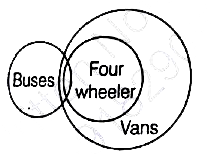Statements:-
Some buses are four wheelers.
All four wheelers are vans.
Conclusions:-
I. Some vans are buses.
II. Some buses are vans
if only Conclusion 1 follows
if only Conclusion II follows
if both Conclusions l and II follow (
if none of the conclusion follows
The correct Answer is:C
As per the question

Hence, both Conclusions I an II follow.
Topper's Solved these Questions
- BOOK - ARIHANT PUBLICATIONCHAPTER - SYLLOGISMEXERCISE - LET US PRACTICE (EXPERT LEVEL EXERCISE)11videos
SYLLOGISM
- BOOK - ARIHANT PUBLICATIONCHAPTER - SYLLOGISMEXERCISE - LET US PRACTICE (EXPERT LEVEL EXERCISE)11videos
SYLLOGISM
- BOOK - ARIHANT PUBLICATIONCHAPTER - STATEMENT AND COURSE OF ACTION EXERCISE - LET US PRACTICE (B EXPERT LEVEL EXERCISE)11videos
STATEMENT AND COURSE OF ACTION
- BOOK - ARIHANT PUBLICATIONCHAPTER - VERIFICATION OF TRUTH OF THE STATEMENT EXERCISE - LET US PRACTICE30videos
VERIFICATION OF TRUTH OF THE STATEMENT
Similar Questions
Statement :- Some fruits are vegetables. All vegetables are plants.
Conclusions :- I. Some plants are vegetables. II. Some fruits are plantsView SolutionStatements:- Some cars are buses. All cars are caves.
Conclusions:- I. Some caves are not buses. II. Some caves are buses. III. No cave is a bus. IV. Some caves are cars.View Solution
Knowledge Check
- Question 1 - Select One
In each of the following questions, two statements are given followed by two/four conclusions I, II III and IV. You have to consider the two statements to be true even if they seem to be at variance from commonly known facts. You have to decide which of the given conclusions, if any, follow from the given statements.
Statements :
a) Some buses are four wheelers.
(b) All four wheelers are vans.
Conclusions :
I. Some vans are buses.
II. Some buses arc vans.AEither conclusion I or II followsBBoth conclusions I and II followCOnly conclusion I followsDOnly conclusion II follows - Question 2 - Select One
Consider the given statements to be true and decide which of the given Conclusions/assumptions can definitely be drawn from the given statements.
Statements :
Some cars are buses.
All cars are caves.
Conclusions :
I. Some caves are not buses.
II. Some caves are buses.
III. No cave is a bus.
IV. Some caves are cars.AOnly Conclusion I followsBOnly Conclusion II followsCOnly Conclusions II and IV followDOnly Conclusion IV follows - Question 3 - Select One
Read the given statement(s) and conclusions carefully and select which of the conclusions logically follow(s) from the statement(s)
Statement:
∗ All cars are four wheelers
∗ All four-wheelers are vehicles.
Conclusions
1. All cars are vehicle
2. Some vehicles are four-wheelers.ANo conclusion follow.BOnly conclusion 2 follows.COnly conclusion 1 follows.DAll the conclusions follow.
Statements:- (i) Some pens are pencils. (ii) All pencils are erasers.
Conclusions:- I. Some pencils are not pens. II. Some erasers are not pens.View SolutionStatements: Some tables are glasses.
All trees are tables.
Conclusions: I Some trees are glasses.
II Some glasses are trees.View SolutionStatements: Some machines are racks.
All wheels are machines.
Conclusions: I Some wheels are racks.
II Some racks are wheels.View SolutionStatements: Some ministers are clerks.
All clerks are businessmen.
Conclusions: I Some ministers are businessmen.
II All businessmen are clerks.View SolutionIn each of the following questions, two statements are given followed by two/four conclusions I, II, III and IV. You have to consider the two statements to be true even if they seem to be at variance from commonly known facts. You have to decide which of the given conclusions, if any, follow from the given statements.
Statements :
(a) All buses are houses.
(b) Some houses are lakes.
Conclusions :
I. Some buses are lakes.
II. Some lakes are buses.
III. Some lakes are houses.
IV. Some houses are buses.View Solution

